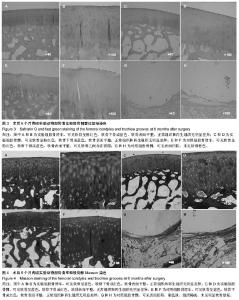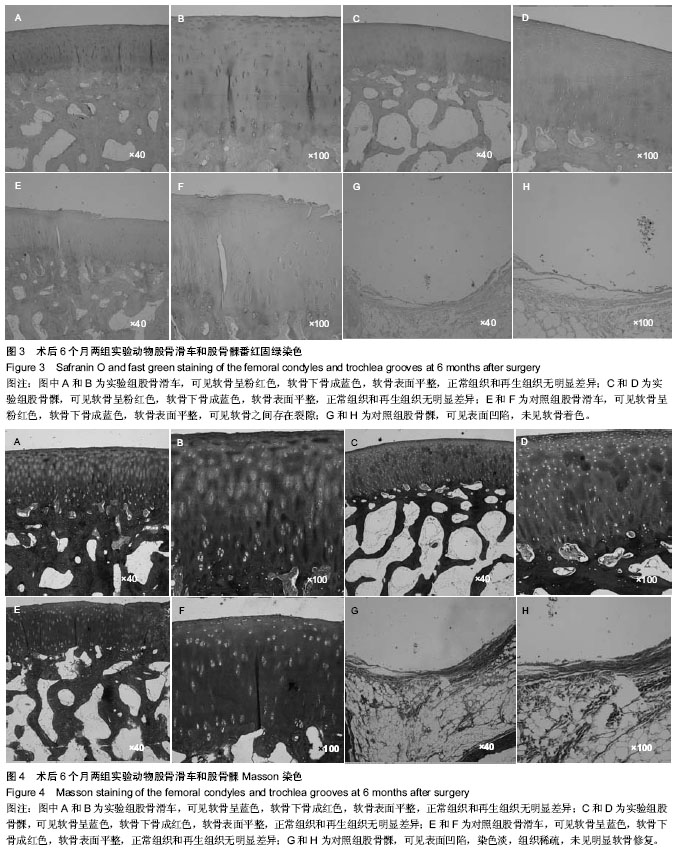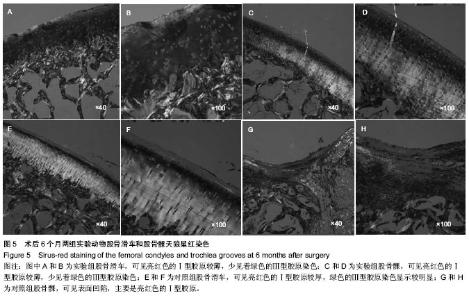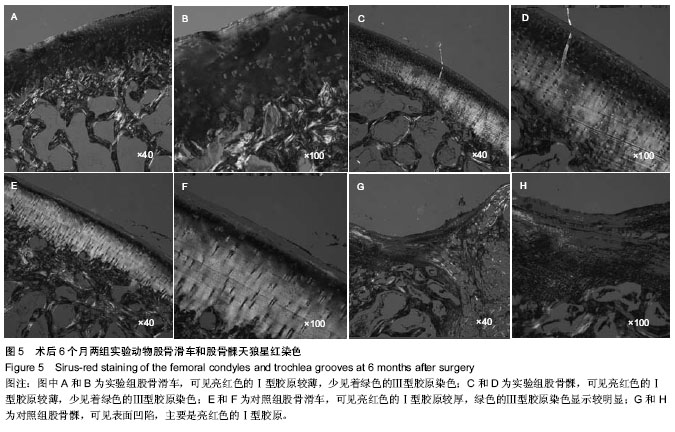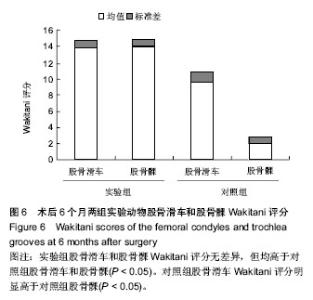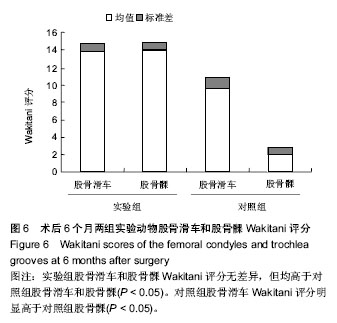Chinese Journal of Tissue Engineering Research ›› 2014, Vol. 18 ›› Issue (43): 6907-6913.doi: 10.3969/j.issn.2095-4344.2014.43.004
Previous Articles Next Articles
Micro-fracture enhanced by autologous bone marrow mesenchymal stem cells extracellular matrix scaffold to treat articular cartilage defects in the knee of pigs
Li Xiang-quan, Tang Cheng, Song Ke-rong, Jin Cheng-zhe
- Nanjing Hospital of Nanjing Medical University, Nanjing 210006, Jiangsu Province, China
-
Received:2014-07-23Online:2014-10-15Published:2014-10-15 -
Contact:Jin Cheng-zhe, M.D., Associate chief physician, Nanjing Hospital of Nanjing Medical University, Nanjing 210006, Jiangsu Province, China -
About author:Li Xiang-quan, Master, Physician, Nanjing Hospital of Nanjing Medical University, Nanjing 210006, Jiangsu Province, China -
Supported by:the Key Medical Personnel Projects of Jiangsu Province, No. RC2011017
CLC Number:
Cite this article
Li Xiang-quan, Tang Cheng, Song Ke-rong, Jin Cheng-zhe. Micro-fracture enhanced by autologous bone marrow mesenchymal stem cells extracellular matrix scaffold to treat articular cartilage defects in the knee of pigs [J]. Chinese Journal of Tissue Engineering Research, 2014, 18(43): 6907-6913.
share this article
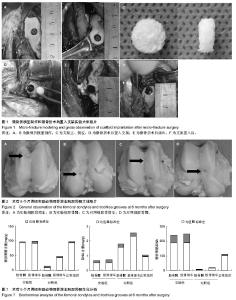
2.1 大体观察结果 术后6个月,手术伤口愈合良好,无化脓感染现象,6只实验动物均存活。打开关节腔可见,实验组和对照组膝关节均无明显关节炎表现,关节液成淡黄色,透明。实验组股骨滑车和股骨髁均可见良好的软骨修复,对照组股骨滑车软骨修复较好,股骨髁未见明显再生组织填充。实验组股骨滑车和股骨髁填充组织有光泽,且在外观上与周围软骨组织类似,而对照组股骨滑车再生组织表面毛糙,与周围软骨相差较大(图2)。 2.2 组织学染色结果 术后6个月,番红固绿染色可见实验组股骨滑车和股骨髁表面平整,软骨区域着红色,软骨下骨成绿色,染色深,滑车区域和股骨髁区域染色无明显差异。对照组股骨滑车表面平整,修复组织着色浅,软骨下骨修复欠佳;对照组股骨髁表面缺损较大,未见软骨修复(图3)。Masson染色结果类似番红固绿染色,实验组软骨下骨修复良好,对照组修复欠佳(图4)。天狼星红染色可见实验组胶原排列情况明显优于对照组(图5)。 2.3 组织学评分 术后6个月,实验组的股骨滑车Wakitani评分为13.38±0.98,股骨髁为14.00±0.89,对照组股骨滑车评分为9.67±1.21,股骨髁为2.00±0.89。实验组股骨髁和股骨滑车评分高于对照组,差异有显著性意义(P < 0.05);实验组股骨髁和股骨滑车Wakitani评分差异无显著性意义(P > 0.05);对照组股骨滑车评分与股骨髁比较差异有显著性意义(P < 0.05),见图6。 2.4 生化成分分析 实验组和对照组在术后6个月内均可测到糖胺聚糖的表达。实验组股骨髁糖胺聚糖的含量为(92.938 3±3.362 8) mg/g,股骨滑车为(93.533 3± 3.840 9) mg/g,对照组股骨髁糖胺聚糖的含量为(9.896 7± 4.370 4) mg/g,股骨滑车为(44.773 3±3.916 4) mg/g,正常组织糖胺聚糖含量为(93.756 7±4.315 5) mg/g。实验组股骨髁和股骨滑车的糖胺聚糖含量差异无显著性意义(P > 0.05);对照组股骨滑车糖胺聚糖含量高于股骨髁,差异有显著性意义(P < 0.05)。实验组股骨滑车和股骨髁糖胺聚糖含量相应高于对照组,差异有显著性意义(P < 0.05),见图7。 术后6个月,实验组股骨髁和股骨滑车DNA含量分别为(0.518 3±0.134 5) mg/g,(0.526 7±0.161 5) mg/g,对照组股骨髁和股骨滑车DNA含量分别为(1.566 7± 0.206 6) mg/g和(2.318 3±0.200 1) mg/g,正常组织为(0.931 7±0.089 5) mg/g;实验组股骨髁和股骨滑车DNA含量差异无显著性意义(P > 0.05),但均相应低于对照组,差异有显著性意义(P < 0.05)。对照组股骨滑车DNA含量低于股骨髁,差异有显著性意义(P < 0.05)。实验组的DNA含量和正常软骨差异有显著性意义(P < 0.05),见图7。 实验组股骨髁和股骨滑车糖胺聚糖/DNA含量明显高于对照组,差异有显著性意义(P < 0.05);对照组股骨髁数值低于股骨滑车,但差异无显著性意义(P > 0.05),见图7。"
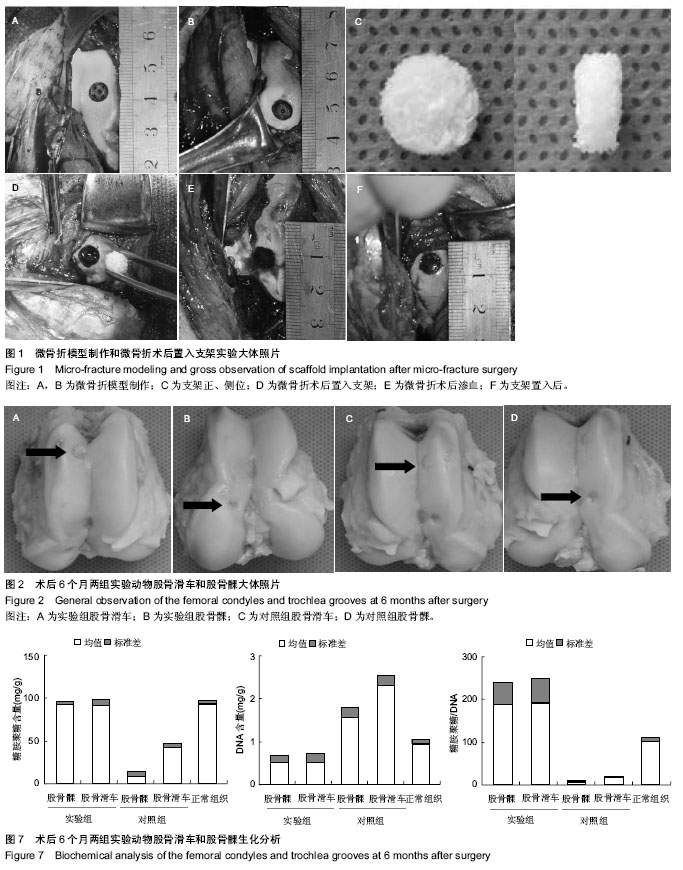
| [1] Hong E, Reddi AH.MicroRNAs in chondrogenesis, articular cartilage, and osteoarthritis: implications for tissue engineering.Tissue Eng Part B Rev. 2012;18(6):445-453. [2] Bhosale AM, Richardson JB.Articular cartilage: structure, injuries and review of management.Br Med Bull. 2008;87:77-95. [3] Bedi A, Feeley BT, Williams RJ 3rd.Management of articular cartilage defects of the knee.J Bone Joint Surg Am. 2010; 92(4):994-1009. [4] Mollon B, Kandel R, Chahal J,et al.The clinical status of cartilage tissue regeneration in humans.Osteoarthritis Cartilage. 2013;21(12):1824-1833. [5] Nukavarapu SP, Dorcemus DL.Osteochondral tissue engineering: current strategies and challenges.Biotechnol Adv. 2013;31(5):706-721. [6] Yin Z, Yang X, Jiang Y,et al. Platelet-rich plasma combined with agarose as a bioactive scaffold to enhance cartilage repair: an in vitro study.J Biomater Appl. 2014;28(7): 1039-1050. [7] Gille J, Schuseil E, Wimmer J,et al.Mid-term results of Autologous Matrix-Induced Chondrogenesis for treatment of focal cartilage defects in the knee.Knee Surg Sports Traumatol Arthrosc. 2010;18(11):1456-1464. [8] Xing L, Jiang Y, Gui J,et al.Microfracture combined with osteochondral paste implantation was more effective than microfracture alone for full-thickness cartilage repair. Knee Surg Sports Traumatol Arthrosc. 2013;21(8):1770-1776. [9] Diederichs S, Baral K, Tanner M,et al. Interplay between local versus soluble transforming growth factor-beta and fibrin scaffolds: role of cells and impact on human mesenchymal stem cell chondrogenesis.Tissue Eng Part A. 2012;18(11-12): 1140-1150. [10] Jin CZ, Park SR, Choi BH,et al. In vivo cartilage tissue engineering using a cell-derived extracellular matrix scaffold. Artif Organs. 2007;31(3):183-192. [11] Jin CZ, Cho JH, Choi BH,et al.The maturity of tissue- engineered cartilage in vitro affects the repairability for osteochondral defect.Tissue Eng Part A. 2011;17(23-24): 3057-3065. [12] Hui JH, Ren X, Afizah MH,et al.Oligo[poly(ethylene glycol) fumarate] hydrogel enhances osteochondral repair in porcine femoral condyle defects.Clin Orthop Relat Res. 2013;471(4): 1174-1185. [13] Gomoll AH, Farr J, Gillogly SD,et al.Surgical management of articular cartilage defects of the knee.Instr Course Lect. 2011; 60:461-483. [14] Luo QZ, Lin L, Gong Z,et al.Positive association of major histocompatibility complex class I chain-related gene A polymorphism with leukemia susceptibility in the people of Han nationality of Southern China.Tissue Antigens. 2011; 78(3):178-184. [15] Theodoropoulos J, Dwyer T, Whelan D,et al. Microfracture for knee chondral defects: a survey of surgical practice among Canadian orthopedic surgeons.Knee Surg Sports Traumatol Arthrosc. 2012;20(12):2430-2437. [16] Behery O, Siston RA, Harris JD,et al.Treatment of cartilage defects of the knee: expanding on the existing algorithm.Clin J Sport Med. 2014;24(1):21-30. [17] Knutsen G, Drogset JO, Engebretsen L,et al.A randomized trial comparing autologous chondrocyte implantation with microfracture. Findings at five years.J Bone Joint Surg Am. 2007;89(10):2105-2112. [18] Meretoja VV, Dahlin RL, Kasper FK,et al. Enhanced chondrogenesis in co-cultures with articular chondrocytes and mesenchymal stem cells.Biomaterials. 2012;33(27): 6362-6369. [19] Hangody L, Kish G, Kárpáti Z, et al. Mosaicplasty for the treatment of articular cartilage defects: application in clinical practice.Orthopedics. 1998;21(7):751-756. [20] Dorotka R, Bindreiter U, Macfelda K,et al. Marrow stimulation and chondrocyte transplantation using a collagen matrix for cartilage repair.Osteoarthritis Cartilage. 2005;13(8):655-664. [21] Behrens P, Bitter T, Kurz B,et al. Matrix-associated autologous chondrocyte transplantation/implantation (MACT/MACI)--5-year follow-up.Knee. 2006;13(3):194-202. [22] Pittenger MF, Mackay AM, Beck SC,et al.Multilineage potential of adult human mesenchymal stem cells.Science. 1999;284(5411):143-147. [23] Reilly GC, Engler AJ. Intrinsic extracellular matrix properties regulate stem cell differentiation. J Biomech. 2010;43(1): 55-62. [24] Chen H, Chevrier A, Hoemann CD,et al. Bone marrow stimulation of the medial femoral condyle produces inferior cartilage and bone repair compared to the trochlea in a rabbit surgical model.J Orthop Res. 2013;31(11):1757-1764. [25] Matzat SJ, van Tiel J, Gold GE,et al. Quantitative MRI techniques of cartilage composition.Quant Imaging Med Surg. 2013;3(3):162-174. [26] Domayer SE, Welsch GH, Nehrer S,et al.T2 mapping and dGEMRIC after autologous chondrocyte implantation with a fibrin-based scaffold in the knee: preliminary results.Eur J Radiol. 2010;73(3):636-642. [27] Watanabe A, Boesch C, Anderson SE,et al. Ability of dGEMRIC and T2 mapping to evaluate cartilage repair after microfracture: a goat study.Osteoarthritis Cartilage. 2009; 17(10):1341-1349. [28] Kobayashi H, Hirata M, Saito T,et al.Transcriptional induction of ADAMTS5 protein by nuclear factor-κB (NF-κB) family member RelA/p65 in chondrocytes during osteoarthritis development.J Biol Chem. 2013;288(40):28620-28629. [29] van Buul GM, Villafuertes E, Bos PK,et al.Mesenchymal stem cells secrete factors that inhibit inflammatory processes in short-term osteoarthritic synovium and cartilage explant culture.Osteoarthritis Cartilage. 2012;20(10):1186-1196. |
| [1] | Pu Rui, Chen Ziyang, Yuan Lingyan. Characteristics and effects of exosomes from different cell sources in cardioprotection [J]. Chinese Journal of Tissue Engineering Research, 2021, 25(在线): 1-. |
| [2] | Lin Qingfan, Xie Yixin, Chen Wanqing, Ye Zhenzhong, Chen Youfang. Human placenta-derived mesenchymal stem cell conditioned medium can upregulate BeWo cell viability and zonula occludens expression under hypoxia [J]. Chinese Journal of Tissue Engineering Research, 2021, 25(在线): 4970-4975. |
| [3] | Hou Jingying, Yu Menglei, Guo Tianzhu, Long Huibao, Wu Hao. Hypoxia preconditioning promotes bone marrow mesenchymal stem cells survival and vascularization through the activation of HIF-1α/MALAT1/VEGFA pathway [J]. Chinese Journal of Tissue Engineering Research, 2021, 25(7): 985-990. |
| [4] | Shi Yangyang, Qin Yingfei, Wu Fuling, He Xiao, Zhang Xuejing. Pretreatment of placental mesenchymal stem cells to prevent bronchiolitis in mice [J]. Chinese Journal of Tissue Engineering Research, 2021, 25(7): 991-995. |
| [5] | Liang Xueqi, Guo Lijiao, Chen Hejie, Wu Jie, Sun Yaqi, Xing Zhikun, Zou Hailiang, Chen Xueling, Wu Xiangwei. Alveolar echinococcosis protoscolices inhibits the differentiation of bone marrow mesenchymal stem cells into fibroblasts [J]. Chinese Journal of Tissue Engineering Research, 2021, 25(7): 996-1001. |
| [6] | Fan Quanbao, Luo Huina, Wang Bingyun, Chen Shengfeng, Cui Lianxu, Jiang Wenkang, Zhao Mingming, Wang Jingjing, Luo Dongzhang, Chen Zhisheng, Bai Yinshan, Liu Canying, Zhang Hui. Biological characteristics of canine adipose-derived mesenchymal stem cells cultured in hypoxia [J]. Chinese Journal of Tissue Engineering Research, 2021, 25(7): 1002-1007. |
| [7] | Geng Yao, Yin Zhiliang, Li Xingping, Xiao Dongqin, Hou Weiguang. Role of hsa-miRNA-223-3p in regulating osteogenic differentiation of human bone marrow mesenchymal stem cells [J]. Chinese Journal of Tissue Engineering Research, 2021, 25(7): 1008-1013. |
| [8] | Lun Zhigang, Jin Jing, Wang Tianyan, Li Aimin. Effect of peroxiredoxin 6 on proliferation and differentiation of bone marrow mesenchymal stem cells into neural lineage in vitro [J]. Chinese Journal of Tissue Engineering Research, 2021, 25(7): 1014-1018. |
| [9] | Zhu Xuefen, Huang Cheng, Ding Jian, Dai Yongping, Liu Yuanbing, Le Lixiang, Wang Liangliang, Yang Jiandong. Mechanism of bone marrow mesenchymal stem cells differentiation into functional neurons induced by glial cell line derived neurotrophic factor [J]. Chinese Journal of Tissue Engineering Research, 2021, 25(7): 1019-1025. |
| [10] | Duan Liyun, Cao Xiaocang. Human placenta mesenchymal stem cells-derived extracellular vesicles regulate collagen deposition in intestinal mucosa of mice with colitis [J]. Chinese Journal of Tissue Engineering Research, 2021, 25(7): 1026-1031. |
| [11] | Pei Lili, Sun Guicai, Wang Di. Salvianolic acid B inhibits oxidative damage of bone marrow mesenchymal stem cells and promotes differentiation into cardiomyocytes [J]. Chinese Journal of Tissue Engineering Research, 2021, 25(7): 1032-1036. |
| [12] | Wang Xianyao, Guan Yalin, Liu Zhongshan. Strategies for improving the therapeutic efficacy of mesenchymal stem cells in the treatment of nonhealing wounds [J]. Chinese Journal of Tissue Engineering Research, 2021, 25(7): 1081-1087. |
| [13] | Wang Shiqi, Zhang Jinsheng. Effects of Chinese medicine on proliferation, differentiation and aging of bone marrow mesenchymal stem cells regulating ischemia-hypoxia microenvironment [J]. Chinese Journal of Tissue Engineering Research, 2021, 25(7): 1129-1134. |
| [14] | Kong Desheng, He Jingjing, Feng Baofeng, Guo Ruiyun, Asiamah Ernest Amponsah, Lü Fei, Zhang Shuhan, Zhang Xiaolin, Ma Jun, Cui Huixian. Efficacy of mesenchymal stem cells in the spinal cord injury of large animal models: a meta-analysis [J]. Chinese Journal of Tissue Engineering Research, 2021, 25(7): 1142-1148. |
| [15] | Chen Junyi, Wang Ning, Peng Chengfei, Zhu Lunjing, Duan Jiangtao, Wang Ye, Bei Chaoyong. Decalcified bone matrix and lentivirus-mediated silencing of P75 neurotrophin receptor transfected bone marrow mesenchymal stem cells to construct tissue-engineered bone [J]. Chinese Journal of Tissue Engineering Research, 2021, 25(4): 510-515. |
| Viewed | ||||||
|
Full text |
|
|||||
|
Abstract |
|
|||||
